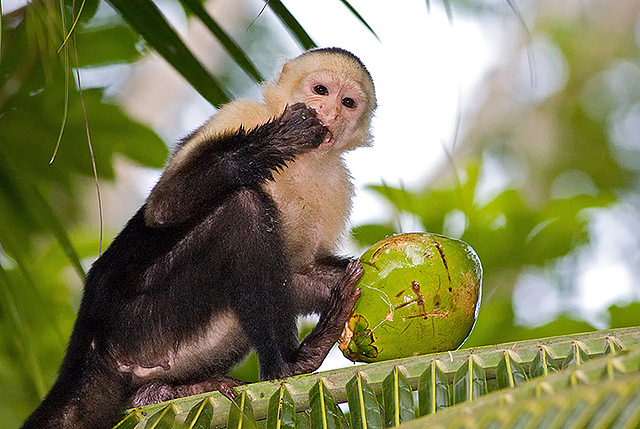Nutrition
The Cebus capucinus species eat a variety of foods in
their diet. Their primary diet usually consists of fruit and
insects. However, they also less commonly eat vertebrate prey as
well as leaves and flowers (Chapman, Fedigan 1990). Between
different groups of C. capucinus, the diets can vary
slightly as a result of a few factors. Many of the differences
are contributed to the availability of the foods in the given
groups’ areas (Chapman, Fedigan 1990). Areas where fruit and
insects are less available will result in a higher occurrence of
killing and eating vertebrates (Fedigan 1990). Along with
availability, the tradition of a group of which food is
acceptable to eat also leads to difference in diet among groups
(Chapman, Fedigan 1990). Another hypothesis dealing with
variance in group diet has to do with the profitability of
certain foods. This is to say that the nutritional value and
energy source from the food compared to the amount of energy
needed to acquire the food is a profitable ratio
(Chapman, Fedigan 1990). If a group has to expel too much energy for a
certain food that does not return the energy or nutritional
value back to the group, they will not eat that food as much.
C. capucinus, or white-faced capuchin monkeys, find their food in a variety
of ways as well. To gather insects, males generally scare them out of the
ground by searching through forest floor debris, while females and young
generally bite into hollow trees to find insect larva
(Fedigan 1990). Other
methods include removing the bark from
 trees, flipping rocks, and breaking
open fruit on rocks (Chapman, Fedigan 1990). The hunting of vertebrates can
either be done in groups or, less commonly, individually. Groups consist of
mostly males that corner and chase prey until they are brought to the ground
where they are then killed and eaten while still alive. Individual hunting
usually involves a male who will kill a prey that is already on the ground
such as a lizard or squirrel (Fedigan 1990). Although most hunting is done
by males, females sometimes hunt as well but they are usually are more
successful than the males at insect gathering (Fedigan 1990).
trees, flipping rocks, and breaking
open fruit on rocks (Chapman, Fedigan 1990). The hunting of vertebrates can
either be done in groups or, less commonly, individually. Groups consist of
mostly males that corner and chase prey until they are brought to the ground
where they are then killed and eaten while still alive. Individual hunting
usually involves a male who will kill a prey that is already on the ground
such as a lizard or squirrel (Fedigan 1990). Although most hunting is done
by males, females sometimes hunt as well but they are usually are more
successful than the males at insect gathering (Fedigan 1990).